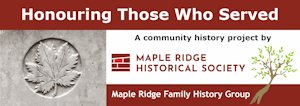Private Arthur Norman HACKNEY
Regimental Number: 2030304
Enlistment Date / Location / Unit: 6 July 1917 / Vancouver / 72nd Regiment, Seaforth Highlanders of Canada
Birth Date / Location: 1882 May 26 / London, Middlesex, England. (1881 on Attestation)
Parents: Alfred Hackney, MD and Marion Lawford
Occupation on Enlistment: Farmer
Date of Death / Location: 9 August 1918 / Battle of Amiens
Age at Death: 36
Unit on Date of Death, or on Demobilization: 29th Battalion
Circumstances of Death: Killed in Action at Amiens
Cemetery or Memorial: Rosieres Communal Cemetery Extension, 8-3.4 miles northwest of Roye, France Plot 1, Row B, Grave 25
Medals / Awards: 1914-15 Star, British War Medal, Victory Medal
Where commemorated: Canadian Virtual War Memorial, Veterans Affairs Canada; First World War Book of Remembrance page 421, Memorial Chamber, Parliament Buildings, Ottawa, ON; Maple Ridge Cenotaph, Maple Ridge, BC; Maple Ridge Legion Branch #88 Memorial Plaque; Municipality of Maple Ridge Honour Roll, St John the Divine Anglican Church, Maple Ridge, BC; Holy Spirit Anglican Church Memorial Plaque, Whonnock, Maple Ridge, BC; Lake Centre plaque, Maple Ridge, BC; Whonnock’s Roll of Honour in the C.E.F.; The Gold Stripe Roll of Honour, Maple Ridge, page 89; Auckland War Memorial Museum, World War 1 Hall of Memories Panel; Museums of Auckland Nominal Ross Vol 1, Page 290, online Cenotaph
Arthur Norman Hackney was born 26 May 1882 in England. He became an orphan at age 4 with the deaths of his mother Marion Lawford in 1884 and his father Alfred Hackney in 1886. He and his three brothers and sister were raised by relatives.
Arthur immigrated to Canada in 1900 and was a lodger on the Spilsbury farm in Whonnock in 1901. On 10 December 1901 Arthur enlisted in Vancouver and served as a private with the 2nd Canadian Mounted Rifles in the South African War (Regimental No. 421). He was 21 years and 9 months old. He was awarded the Queen’s South Africa Medal with 3 clasps: Cape Colony, Transvaal and South Africa 1902. Arthur returned to Whonnock to farm.
It is unknown why he left Canada, however Arthur immigrated to New Zealand and was farming at Waiharara, North Cape on the North Island when he enlisted on 12 August 1914 in the New Zealand Expeditionary Force (Regimental No. 12/559). He was 32 years old. He arrived in Egypt with the NZEF 1st Auckland Infantry Battalion on 4 December 1914. He landed at Gallipoli (Turkey) 8 May 1915 and received a shrapnel wound to the left thigh on 16 June which resulted in a medical transfer to Malta and then to England. Two months later on 16 September he returned to Gallipoli until the evacuation on 29 December 1915.
Arthur’s regiment transferred to the Armentieres sector of France in April 1916. On 3 July Arthur was buried in a trench by a high explosive shell and was rendered unconscious for 48 hours. When he regained consciousness he was unable to see. He was evacuated to England for treatment and convalescence, where he regained sight in his left eye but the right eye remained damaged. He received a medical discharge 24 January 1917 and was returned to New Zealand as permanently unfit for war service.
Arthur returned to Canada arriving on 30 June 1917; six days later he enlisted in the 72nd Regiment Seaforth Highlanders of Canada in Vancouver. Although he disclosed his impaired eyesight, he was deemed fit for service. Arthur arrived in England 14 December 1917 and was in France on 27 March 1918. On 2nd April he was transferred to the 29th Battalion, followed by a short duration transfer to Canadian Machine Gun Corps, then back to the 29th Battalion in June.
With the 29th Arthur fought in the Battle of Amiens where he lost his life on 8 August 1918. The Circumstances of Casualty record notes: “He was instantly killed by machine gun fire whilst taking part in an attack on Rosieres, when about halfway between the “jumping off” point and the town.”
A.N. Hackney’s name was on the Cenotaph when it was unveiled in 1923.
(Updated 29-Jan-2024)
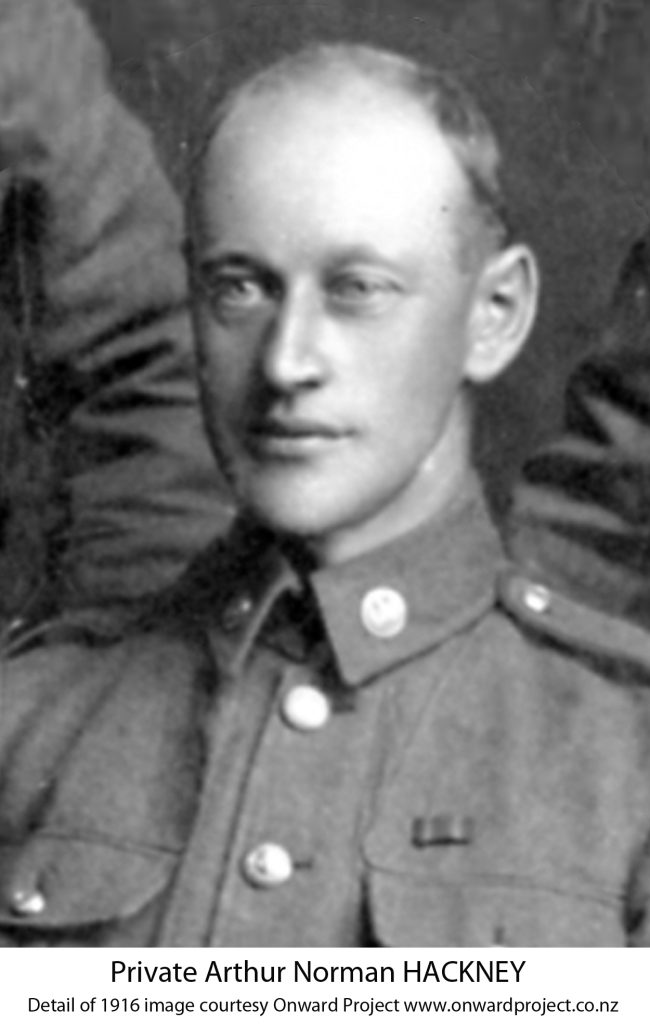
Private Charles Edward Russell HALL
Regimental Number: 50486
Enlistment Date / Location / Unit: 9 January 1915 / Victoria, BC / 2nd Canadian Mounted Rifles
Birth Date / Location: 8 May 1896 / Gateshead on Tyne, England
Parents: William Hall and Julia Murray
Occupation on Enlistment: Bank Clerk (Bank of Montreal)
Date of Death / Location: 27 September 1918
Age at Death: 22
Unit on Date of Death, or on Demobilization: Canadian Army Medical Corps, 3rd Field Ambulance
Circumstances of Death: Killed in action
Cemetery or Memorial: Sains-Les-Marquion British Cemetery, Pas-de-Calais, France,I.D. 29
Where commemorated: First World War Book of Remembrance, page 421 Memorial Chamber, Parliament Buildings, Ottawa, Ontario; Maple Ridge Cenotaph, Maple Ridge, BC; Maple Ridge Legion Branch #88 Memorial Plaque; Municipality of Maple Ridge Honor Roll, St John the Divine Anglican Church, Maple Ridge, BC; Memorial of the Great War 1914-1918: A Record of Service, (Montreal: Bank of Montreal, 1921) 40-41.
Charles “Edward” Russell Hall was born in Gateshead-on-Tyne, England, on 8 May 1896. He came to Canada with his parents and five siblings in 1912 and settled in Port Haney. His oldest sister came to Canada in 1920.
In September 1912, Edward entered the service of the Bank of Montreal at Port Haney as a clerk. He was later transferred to the Summerland Branch.
On 9 January 1915 Edward enlisted in Victoria, BC with the 2nd Canadian Mounted Rifles. The 30 September 1915 Vancouver Daily World stated that Edward was one of the men who enlisted from “F” Company of the 104th Regiment in Maple Ridge. He was 18 years old, 1.7 meters (5 feet 7 inches) tall, weighed 61 kilograms (134 pounds), and had a fresh complexion, hazel eyes, and dark brown hair. He was serving in France by late September 1915.
Edward became very ill with “trench fever” in July 1917—an infectious disease transmitted by body lice and characterized by fever, headache, pain behind the eyes, weakness, and sore muscles and joints. Upon discharge from hospital, Edward was transferred to the 3rd Canadian Field Ambulance. He served for over three years at the front.
The British Columbian Victory Edition stated that Edward “never faltered in the heavy tasks laid upon the stretcher bearers, working between the artillery and infantry, spending whole nights between the lines, and being tireless in his efforts to bring relief to those wounded.”
“On the last day, hearing there were wounded ahead, he left this party in a comparatively sheltered place, and went on alone into the zone of fire. He was struck in the throat by a fragment of shrapnel, and instantly killed.”
Edward was 22 years old when he was killed by enemy shellfire on 27 September 1918, during the successful Canadian attack along the Canal du Nord in the advance towards Cambrai.
His brother Arnold Theodore Hall, Regimental No. 2323602, enlisted with the Canadian Forestry Corp.
E. Hall’s name was on the Cenotaph when it was unveiled in 1923.
(Updated 23-Jan-2024)
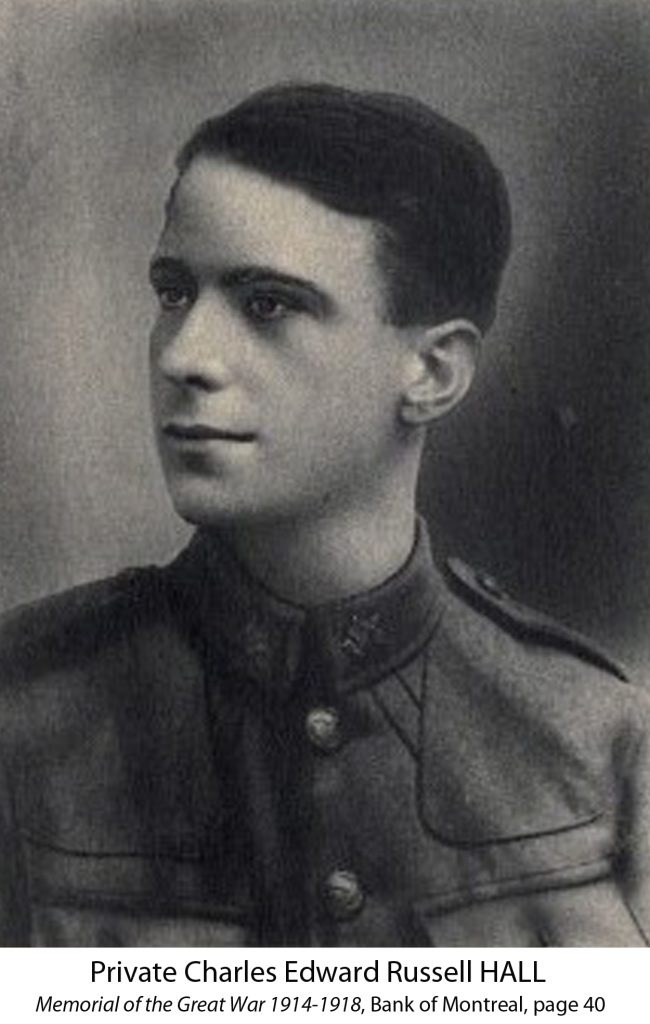
Second Lieutenant James Henry HAMPTON
Regimental Number: 628701 / Second Lieutenant
Enlistment Date / Location / Unit: 4 November 1915 / New Westminster, BC / 47th Battalion
Birth Date / Location: 4 August 1897 / Port Hammond, BC
Parents: William Hampton and Amanda Olver
Occupation on Enlistment: Farmer / Student
Date of Death / Location: 29 October 1918
Age at Death: 21
Unit on Date of Death, or on Demobilization: Royal Air Force, 3rd Squadron
Circumstances of Death: Missing; Death accepted for official purposes
Cemetery or Memorial: Arras Flying Services Memorial, Faubourg-d’Amiens Cemetery, Pas de Calais, France
Where commemorated: Arras Flying Services Memorial, Faubourg-d’Amiens Cemetery, Pas de Calais, France; Canadian Virtual War Memorial, Veterans Affairs Canada; First World War Book of Remembrance page 588, Memorial Chamber, Parliament Buildings, Ottawa, ON; Maple Ridge Cenotaph, Maple Ridge, BC; Maple Ridge Legion Branch #88 Memorial Plaque; Municipality of Maple Ridge Honour Roll, St John the Divine Anglican Church, Maple Ridge, BC; The Gold Stripe Roll of Honour, Maple Ridge, page 89
James “Jimmy” Henry Hampton was one of the younger children born in Port Hammond to William and Amanda (nee Olver) Hampton.
According to the Maple Ridge Museum and Archives the families of William and Amanda arrived in Colorado in 1873 to take up mining. Jimmy’s parents were married in Colorado in 1876. The Hamptons and the Laitys, another family originally from Cornwall, England, left Colorado and arrived in Maple Ridge in 1879. Jimmy grew up on the family dairy farm in a large family of six boys and five girls. He attended the Maple Ridge School and was a member of the Maple Ridge Basketball club.
Jimmy enlisted with the 47th Battalion on 4 November 1915 at the age of 18 years and 3 months; a few weeks later he arrived in England. He was 1.6 meters (5 feet 4 inches) tall, weighed 61 kilograms (135 pounds), had a fresh complexion, grey eyes and brown hair. He had already served 15 months with the 104th Regiment Westminster Fusiliers of Canada.
In August 1916 Jimmy arrived in France. He was a member of a raiding party at the Zouave Valley where he sustained a gunshot wound to the left hip on 13 February 1917. Jimmy was first admitted to No 20 General Hospital, Camiers, France, then transferred to hospitals in England.
Upon discharge from hospital Jimmy resigned from the Canadian Expeditionary Force and on 30 November 1917 commenced training in the Royal Air Force, No 1 Cadet Wing. On 29 October 1918 Jimmy was the pilot of a Sopwith F.1 Camel in France when he was reported missing and a few days later considered deceased for official purposes.
The Hampton family were early settlers in Maple Ridge and are related to the Laity and Mackreth families. The Hampton Farm on 209th Street remains a working farm and is listed in the Maple Ridge Heritage Register. J.H. Hampton’s name was on the Cenotaph when it was unveiled in 1923.
(Updated 25-Jan-2024)
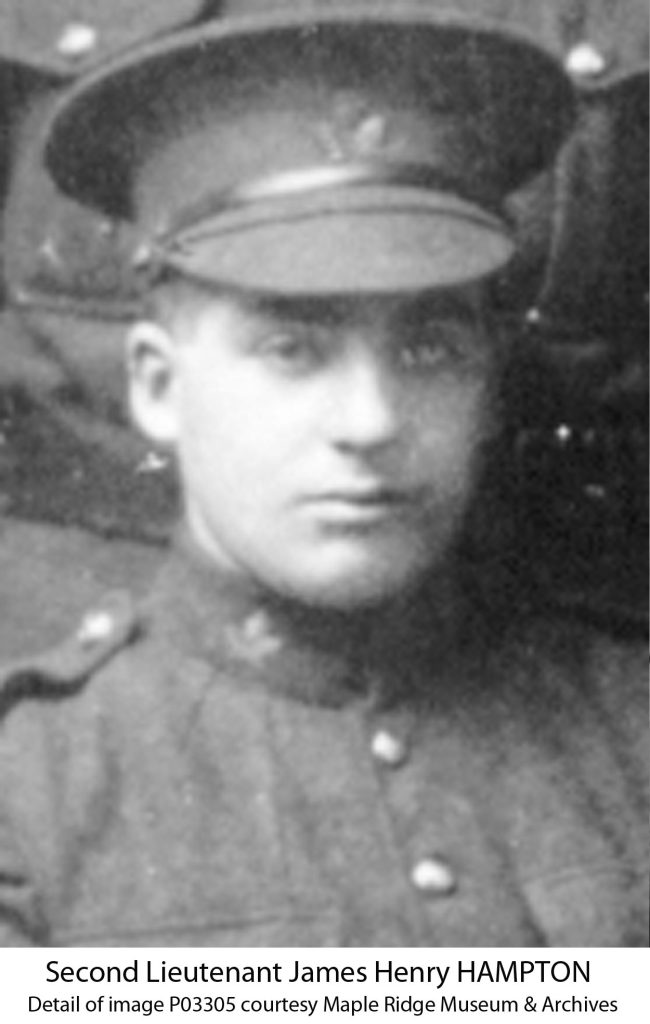
Private David HANNAH
Regimental Number: 108269
Enlistment Date / Location / Unit: 18 December 1914 / Medicine Hat, AB / 3rd Canadian Mounted Rifles
Birth Date / Location: 10 August 1886 / Netherton, Maryport, Cumberland, England
Parents: George Hannah and Jane McCormack
Occupation on Enlistment: Clerk
Date of Death / Location: 2 June 1916 / Sanctuary Wood
Age at Death: 30
Unit on Date of Death, or on Demobilization: 1st Battalion Canadian Mounted Rifles
Circumstances of Death: Missing between 2 – 5 June 1916 near Sanctuary Wood, Ypres, Belgium
Cemetery or Memorial: Menin Gate, Ypres, Belgium, panel 32
Medals / Awards: 1914-15 Star
Where commemorated: First World War Book of Remembrance page 98, Memorial Chamber, Parliament Buildings, Ottawa, ON; Maple Ridge Legion Branch #88 Memorial Plaque; St John the Divine Anglican Church Memorial Plaque, Maple Ridge, BC; Menin Gate Memorial, Ypres, Belgium; Municipality of Maple Ridge Honour Roll, St John the Divine Anglican Church, Maple Ridge, BC; Whonnock Lake Centre plaque, Maple Ridge, BC; Whonnock’s Roll of Honour in the C.E.F.; Maple Ridge, BC; War Memorial Gardens, Maryport, Cumberland, England
David Hannah was the second youngest of the 11 children born to George and Jane (nee McCormack) Hannah. In 1889 David’s brother-in-law Christopher Gill immigrated to the Seattle area of Washington Territory, followed by David’s sister Isabella in 1890 where she married Christopher. The Gills moved to Whonnock about 1909 and remained part of the rural community. David’s brother George immigrated to Seattle in 1900, where he would marry and live for the rest of his life. Brothers Joseph and Herbert emigrated in 1904 and 1910 respectively; both were living in Vancouver in 1911.
David, a railway clerk at the time, arrived in Canada on 14 April 1911 giving his destination as Whonnock, BC, home of his sister Isabella and her husband Christopher Gill.
The three Hannah brothers living in BC enlisted in the Canadian Expeditionary Force. David enlisted on 18 December 1914 in Medicine Hat, AB; Herbert, the youngest, enlisted a few days later on 30 December 1914 in Calgary, AB; and Joseph enlisted 23 July 1915 in New Westminster. George, who was living near Seattle, WA, enlisted in the United States Army in 1918, after the United States entered the war in 1917.
When he enlisted David was 1.7 meters (5 feet 7 inches) tall, had blue eyes and brown hair, and a scar under his chin. He sailed from Canada to England on 12 June 1915 and was in France on 22 September. The 2nd January 1916 saw David now part of the 1st Battalion Canadian Mounted Rifles upon reorganization.
David was in the roughly five month long Battle of Ypres and died near Hill 62. The Circumstances of Death record notes that David was “previously reported Missing, now Killed in Action, at about noon on June 2nd 1916, whilst in a dugout near Sanctuary Wood, during a heavy enemy bombardment, he was instantly killed by a shell, which exploded in the dugout.”
D. Hannah is commemorated on the Whonnock Lake Centre plaque and Whonnock’s Roll of Honour in the C.E.F. as D. Hanna.
(Updated 28-Jan-2024)

Second Lieutenant Robert Hugh HARRIS
Regimental Number: 327 / Second Lieutenant
Enlistment Date / Location / Unit: 10 September 1914 / London, England / 16th (Service) Battalion (Public Schools) of the Middlesex Regiment
Birth Date / Location: Baptized 29 June 1877 / Llanelli (Llanelly), Carmarthenshire Wales
Parents: Edward Charles Harris and Emily Charlotte Morris
Spouse: Annette Constance Browne-Clayton
Occupation on Enlistment: BC Fruit Farmer
Date of Death / Location: 28 September 1916 / The Somme, France
Age at Death: 39
Unit on Date of Death, or on Demobilization: Duke of Wellington, West Riding Regiment (British Army)
Circumstances of Death: Killed in action
Cemetery or Memorial: Thiepval Memorial, Pier and Face 6 A and 6 B
Medals / Awards: 1914-15 Star; British War Medal; Victory Medal
Where commemorated: Maple Ridge Cenotaph, Maple Ridge, BC; Maple Ridge Legion Branch #88 Memorial Plaque; Municipality of Maple Ridge Honor Roll, St John the Divine Anglican Church, Maple Ridge, BC; The Gold Stripe Roll of Honour, Maple Ridge, page 89; Whonnock’s Roll of Honour in the C.E.F.; Holy Spirit Anglican Church Memorial Plaque, Whonnock, Maple Ridge, BC; Whonnock Anglican Church, plaque, Maple Ridge, BC; Brass plaque with regimental crest at St Peter’s Parishioner’s Church, Carmarthen, Dyfed, Llangunnor, Wales
Robert Hugh Harris was born in Wales in 1877 to Edward Charles and Emily Charlotte (nee Morris) Harris. Edward was the Deputy-Chief-Constable of the Carmarthenshire Constabulary in Wales. In 1898 Robert followed his brother James to Canada. They were fruit farmers and ranchers in Ruskin, and then later close to Whonnock Station. They were members of the Badminton Club that played at the Whonnock Hall. The 30 September 1915 Vancouver Daily World stated that both Robert and James were members of “F” Company of the 104th Regiment in Maple Ridge.
Robert married Annette Constance Browne-Clayton on 13 May 1913 at St. Paul’s Church in Whonnock.
Robert and James headed back to England within weeks of the declaration of war. They sailed on the RMS Royal Edward, arriving in Bristol on 19 August 1914. Thirty-nine-year-old Robert enlisted on 10 September 1914 in the Public Schools Battalion of the Middlesex Regiment. His apparent age was recorded as 35. He was 1.85 metres (6 feet 1 inch) tall, weighed 68 kilograms (10 stone, 10 lb/150 pounds) with a fair complexion and brown eyes and hair. On 8 March 1915 He was given a temporary commission in the to the Duke of Wellington’s as an officer. The 13 December 1916 edition of the Daily Colonist reported that served in Gallipoli.
Robert’s wife, Annette Harris had studied to be a nurse at Derbyshire Royal Infirmary prior to her marriage. In 1916 she went to England and worked as a nurse at Queen Mary’s Military Hospital in Whalley, Lancashire before becoming a Special Military Probationer with the Queen Alexandra’s Imperial Military Nursing Service Reserve.
Robert was killed in action during the Somme offensive 28 September 1916 at the age of 39.
His brother James Reginald Harris survived the war, sold his land in Whonnock and retired to Bryntowy, Carmarthen, Wales. Their younger brother, John Smythe Harris, was a Commander of the Royal Navy, Hydrographic Department. He was retired and living in Wimbledon, Surrey, England by 1939.
R.H. Harris’s name was on the Cenotaph when it was unveiled in 1923.
(Updated 06-March-2024)

Private Frederick Morris HART
Regimental Number: 183488
Enlistment Date / Location / Unit: 24 November 1915 / Calgary, AB / 89th Battalion
Birth Date / Location: 3 July 1894 / St. John’s, Newfoundland and Labrador
Parents: George Pilgrim Hart and Maria Elizabeth Morris
Occupation on Enlistment: Labourer, Locomotive Engineer
Date of Death / Location: 14 August 1917 / Mountain Sanatorium, Hamilton, ON
Age at Death: 23
Unit on Date of Death, or on Demobilization: 89th Battalion
Circumstances of Death: Pulmonary Tuberculosis (Phthesis) one year
Lung condition, Tuberculosis in Lungs and bowels
Cemetery or Memorial: Hamilton Cemetery, Hamilton, ON, Section Y, Row 7, #13, Grave No. 1452
Where commemorated: Canadian Virtual War Memorial, Veterans Affairs Canada; First World War Book of Remembrance page 252, Memorial Chamber, Parliament Buildings, Ottawa, ON; Maple Ridge Cenotaph, Maple Ridge, BC; Maple Ridge Legion Branch #88 Memorial Plaque; St John the Divine Anglican Church Memorial Plaque, Maple Ridge, BC; Municipality of Maple Ridge Honor Roll, St John the Divine Anglican Church, Maple Ridge, BC; The Gold Stripe Roll of Honour, Maple Ridge, page 89
Frederick Morris Hart was born in July 1894 in St. John’s, NF. His mother died shortly after his birth; his father remarried, and the family moved to Port Hammond, BC in 1912. Here “Fred” lived and worked as laborer and locomotive engineer.
He enlisted in the Canadian Expeditionary Force on 24 November 1915, in Calgary, AB. Fred was 1.6 meters (5 feet five and one-half inches) tall and weighed 72.5 kilograms (160 pounds); he had brown eyes and hair.
He arrived in England in June 1916 and was in France by August 1916. In September 1916, he was admitted to No.7 Station in Havre, with a middle ear infection, otitis media, a recurring condition he had endured since childhood. He was transferred to England for treatment where he remained on temporary base duty for six months. Fred was transferred back to France in early March 1917; he reported sick 20 March 1917 and was diagnosed with pneumonia. He was eventually transferred to Ontario Military Hospital in Orpington, Kent, England. His condition developed into penumothorax and then into tuberculosis. He was invalided sick to Canada on 11 June 1917 aboard the hospital ship SS Araguaya. Fred was transferred to Mountain Sanatorium in Hamilton, ON where he died on 14 August 1917, at the age of 23. Of the 12 months he spent overseas, he was not even two weeks on the war front.
There is a discrepancy between the Canadian Expeditionary Force’s records and a newspaper obituary article in the St. John’s Daily Star, 20 August 1917. The article stated that Fred had been wounded on two occasions and died of tuberculosis due to weakened lungs from having been gassed. The article also reported that Fred was a drummer. However, there is no record of other wounds or his role as a drummer in his First World War Personnel Records. F. Hart’s name was on the Cenotaph when it was unveiled in 1923.
(Updated 14-Dec-2023)

Private Basil Haviland HERTSLET
Regimental Number: 1037141
Enlistment Date / Location / Unit: 18 May 1916 / Vancouver, BC / Re-enlisted on 22 March 1918 / Vancouver, BC
Birth Date / Location: 11 September 1865 / Richmond, Surrey, England
Parents: Sir Edward and Lady Eden (nee Bull) Hertslet, of Belle Vue House
Spouse: Helen Annie Bousfield
Dependents: Lewis Basil Godfrey Hertslet, Clement Hertslet, and Patrick Hertslet
Occupation on Enlistment: Farmer
Date of Death / Location: 28 April 1818 / Vancouver General Hospital, Military Annex, Vancouver, BC
Age at Death: 53
Unit on Date of Death, or on Demobilization: 238th Battalion
Where & when demobilized: 9 August 1917, QC after first enlistment, deemed medically unfit
Circumstances of Death: Duodenal Ulcer, Peritonitis
Cemetery or Memorial: Mountain View Cemetery, Vancouver, BC, Plot 6, Block 45, Grave 3
Where commemorated: Canadian Virtual War Memorial, Veterans Affairs Canada, First World War Book of Remembrance page 428, Memorial Chamber, Parliament Buildings, Ottawa, ON
Maple Ridge Cenotaph, Maple Ridge, BC
Basil Haviland Hertslet was born in Richmond, Sussex, England. He had a varied career in England, South Africa, and the United States. He married Florence Mary Haselden (1854-1909) on 11 June 1903 in Kensington, London. Soon after his wife’s death in 1909 he immigrated to Canada to settle with his brother Bernard Carr Hertslet at Clive, AB. In 1910, he married Helen Annie Bousfield. In January of 1912 he moved his family to the Kerrisdale neighbourhood in Vancouver, BC.
Basil was 1.8 metres (5 feet eight and one-half inches) tall, weighed 66 kilograms (145 pounds), had hazel eyes and gray hair.
Basil, a married man of 51 with a history of chronic gastritis, with a young wife and three small children went to a recruiting office in May 1916, to volunteer for fighting overseas in the FWW. In order to be accepted, he lied about his age, claiming to be only 42.
Basil arrived in England 22 September 1916 as a member of the 238th Battalion, Canadian Forestry Corp. Then in England, during his stay in a military training camp, he fell sick with gastritis and was transferred to a military hospital. As he did not recover sufficiently within 7 months, in July 1917, he was sent home to Vancouver for further treatment and was discharged from the Army. On 18 July 1917, he sailed to Canada and was discharged on 24 August 1917, in Quebec as medically unfit.
Seven months later in March 1918, after some more gastritis attacks, incomprehensibly, he re-enlisted with the CEF. However, a month later, he was hospitalized again for a duodenal ulcer. There he was operated on and then died on 28 April 1918 of peritonitis. Basil’s widow, Helen, with her three sons moved to Port Haney shortly after the war ended, to live near her brother-in-law, Bernard Hertslet.
The land on which the Hertslet Residence at 11363 240 Street was built was acquired by Basil’s brother Bernard Carr Hertslet through the Soldier Settlement Board. Bernard, Regimental No. 703629, later No. 1037625, also lied about his age in order to serve overseas in the CEF. Basil and Bernard served in the same unit. Ownership of the property passed to Basil and Bernard’s brother, Godfrey Edward Procter Hertslet in 1926. Godfrey began living there shortly after and lived there until he died in 1947. The house is on the Maple Ridge Community Heritage Register.
B Hertslet’s name was added to the Cenotaph in 2000 as part of the Legion’s Millennium project.
(Updated 19-Feb-2023)
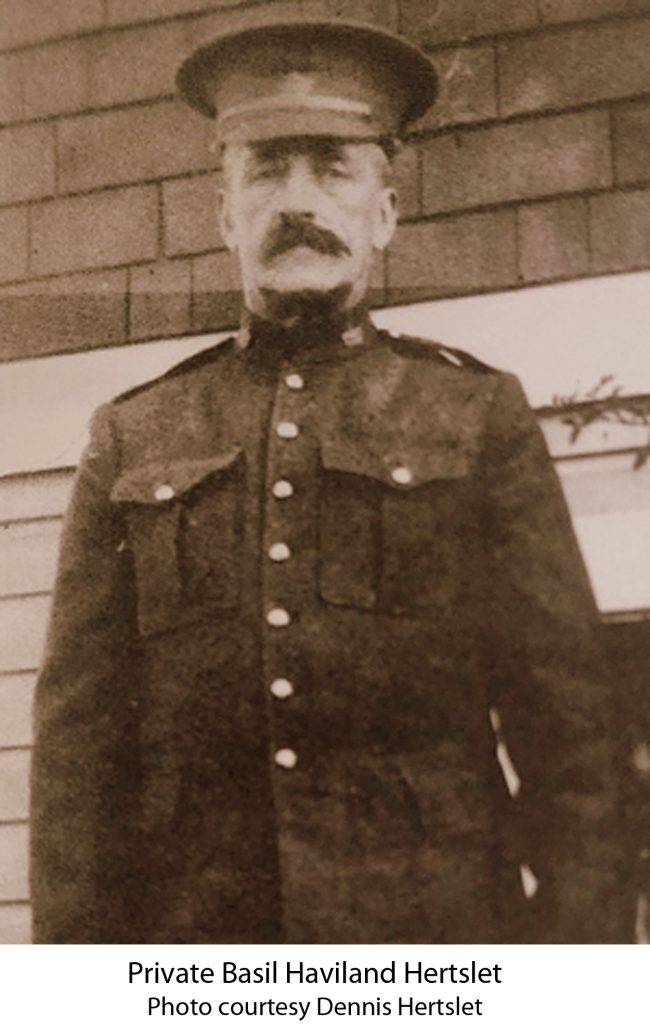
Private William Ernest Howe
Regimental Number: 703733
Enlistment Date / Location / Unit: 24 February 1916 / Nanaimo, BC / 102nd Battalion
Birth Date / Location: 6 June 1896 / Vancouver, BC (1897 on Attestation)
Parents: George Thomas Howe and Louisa Carter
Occupation on Enlistment: Farmer
Date of Death / Location: 3 September 1918 / 33 Casualty Clearing Station, Cherisy, Belgium
Age at Death: 21
Unit on Date of Death, or on Demobilization: Unit: Canadian Infantry (Central Ontario Regiment)
Division: 102nd Battalion.
Circumstances of Death: Near Cherisy, Belgium, dangerously wounded on right leg and right arm on 2 September 1918, attended by 11 Canadian Field Ambulance then brought to No. 33 Casualty Clearing Station where he died the next day.
Cemetery or Memorial: Ligny, St. Flochel British Cemetery, Nord-Pas-de-Calais, France, 4 ½ miles South East of St. Pol, France, Plot 4, Row A, Grave 1, No. 33
Where commemorated: Canadian Virtual War Memorial, Veterans Affairs Canada; First World War Book of Remembrance page 432, Memorial Chamber, Parliament Buildings, Ottawa, ON; Maple Ridge Cenotaph, Maple Ridge, BC; Municipality of Maple Ridge Honor Roll, St John the Divine Anglican Church, Maple Ridge, BC; The Gold Stripe Roll of Honour, Maple Ridge, page 89
William “Ernest” Howe was the son of George Thomas and Louisa (nee Carter) Howe. Louisa’s parents and siblings lived in Port Haney. After her husband George’s death, Louisa, her three sons and two daughters moved to Port Haney.
Ernest was a member of the Port Haney Basketball Club. Before attestation, he enlisted for one year in the New Westminster, 104th Fusiliers Regiment. When he enlisted Ernest Howe was 1.7 meters (5 feet 6 inches) tall and weighed 59 kilograms (132 pounds); he had brown eyes and dark brown hair.
Ernest arrived in England on 28 June 1916; on 11 August 1916 he arrived in France.
In March 1917 he suffered a contusion to his left knee. On 2 September 1918 on the Drocourt-Quéant Line near Cherisy, Belgium he received a gunshot wound which fractured his right leg, and injuries to his left thigh and right arm. He was treated on the field then evacuated to the No 33 Casualty Clearing Station where he died of his injuries on 3 September 1918, just two months before the end of the war. Ernest’s brother George Nelson Howe, Regimental No. 790448, and his mother’s brothers Harry Lewis Walter Carter, Regimental No. 790236 and Edward Obediah “Obie” Carter, Regimental No. 790336, also served.
E. Howe’s name was on the Cenotaph when it was unveiled in 1923.
(Updated 14-Dec-2023)

